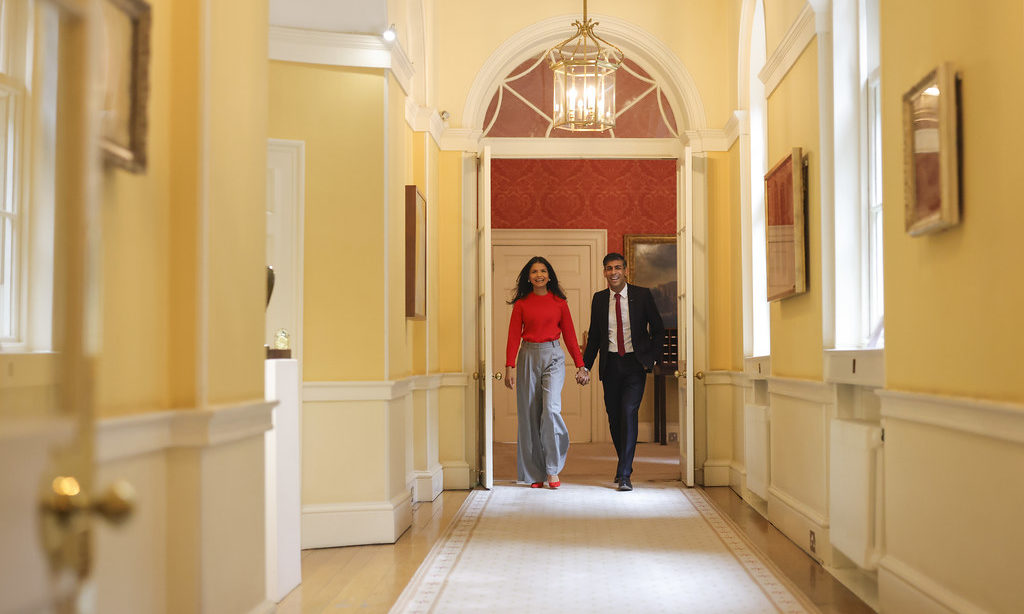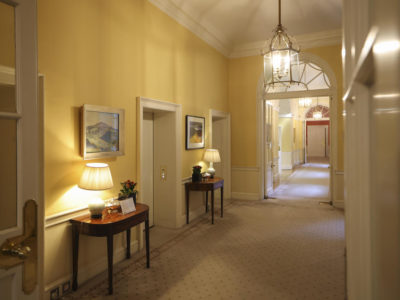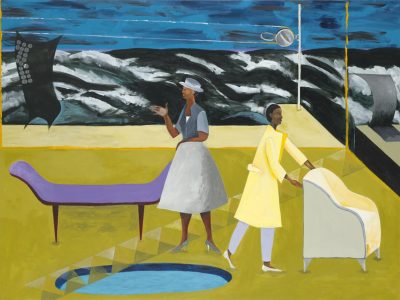For 2023–24’s Museum in Residence, curators at the Government Art Collection worked with the Laing Art Gallery to select a number of pieces from its collection for display within 10 Downing Street.
The Laing Art Gallery is located in the centre of Newcastle upon Tyne and was founded in 1901 by local businessman and philanthropist Alexander Laing. Unusually, Laing commissioned the baroque-style building with its striking art nouveau elements but left no art collection to adorn its walls. Once open to the public however, donations of art soon followed and the gallery gradually amassed one of the region’s most diverse collections. Today, the Laing Art Gallery holds an internationally important collection of British oil paintings, watercolours, ceramics, silver and glassware and hosts regular exhibitions of historic and contemporary art.

Works from the Laing Art Gallery being hung in 10 Downing Street
This year’s display in 10 Downing Street reflects the rich array of artworks within the Laing Art Gallery’s collection. While half of those chosen capture Newcastle’s distinctive cityscape and point to the city’s industrial past, the other half represent the diverse art scene of northeast England and speak to the important role that the region’s art schools played in shaping art teaching throughout the UK. Each artwork in the display is by an artist based in the northeast or who responded to the region’s landmarks and landscapes through their art. Over the coming year, the work of these artists will be encountered by fresh audiences, including No 10 staff and the many visitors who pass through the house throughout the year.

Edward Montgomery Dickey O’Rourke, The Building of the Tyne Bridge, 1928 © copyright reserved
Located at the centre of this display is a large oil painting by Edward Dickey depicting the construction of the Tyne Bridge. The bridge, which links Newcastle upon Tyne and Gateshead, was opened in 1928 and remains an iconic landmark today. The bridge is shown here mid assembly – with the two sides of its distinctive parabolic arch coming together and a crane swinging overhead. Nearby in the display is a work by the Oxfordshire-born Byron Dawson, who settled in Newcastle following the completion of his engineering apprenticeship in the city. Dawson’s painting, Caravans, Figures & Helter Skelter (1930), reproduces a scene from The Hoppings, a long-running travelling fair that has set up annually on the Town Moor at the centre of Newcastle since 1882 and, to this day, plays host to traditional caravans such as that pictured here.
Alongside city scenes and landscapes, this display includes several mid-20th century artworks by figures associated with the region’s progressive art schools. Victor Pasmore’s Girl with Mirror (c.1942–5) offers a rare example of a figurative work from a painter better known for his energetic abstract compositions. In the 1950s and 1960s, Pasmore, along with fellow art teacher Richard Hamilton, made Newcastle a centre for British art and, inspired by the philosophy of the Bauhaus school in Germany, developed a model for UK higher arts education that remains in use today.
Also on display is a work by King’s College (now Newcastle University) graduate Flora Glover, titled The Flood (c.1941). Glover’s painting translates the story of Noah’s Ark into modern form through its muted palette and cubist sensibilities. These artworks are joined by two others that both experiment with materials and composition. The first, Quartz Inset (c. 1965), by another King’s College graduate, Florence Ward, uses plaster to echo the cut quartz of rural landscapes. The other, West Front, Durham (1974), by Kenneth Rowntree, a former Professor of Fine Art at Newcastle University, repurposes a wooden tea chest to recreate the western facade of Durham’s mighty cathedral.

Florence Ward, Quartz Inset, 1965 © the artist’s estate.
We have enjoyed working with the Government Art Collection team in selecting paintings from the Laing Art Gallery. It has enabled us to see the works from a fresh perspective – to hone and highlight narratives about the North East. We are delighted that our wonderful pictures will be seen by a range of people, from the UK and around the world, as they pass through the doors of No 10.
— Julie Milne, Chief Curator of Art Galleries, Tyne & Wear Archives & Museums
The Laing Art Gallery is managed by Tyne & Wear Archives & Museums on behalf of Newcastle City Council.













